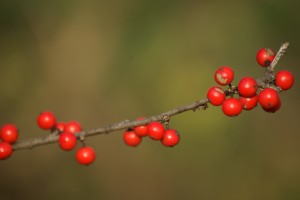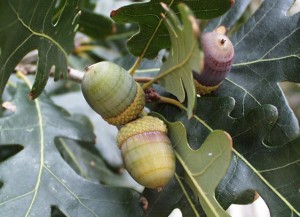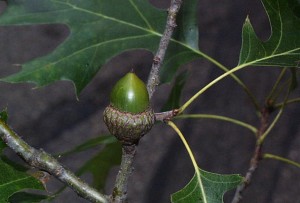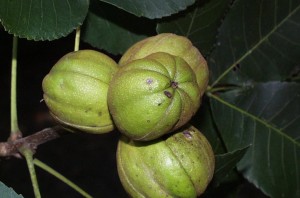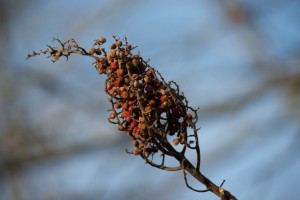Autumn harvest for wildlife
A listing of wildlife mast foods may be found by clicking this link: Wildlife Mast Foods
Harvest season is upon us, a time-immemorial sense of urgency carried on crisp breezes telling us to stock up and store for winter needs. We do our stocking up by tossing boxes and packages and tenderly placing produce, eggs and meat on top of the canned goods in the grocery cart while we harvest our way through the supermarket.
Wildlife takes part of a cycle of stocking up and consuming. Through the summer birds and small mammals have feasted on insects and larva that in their turn feasted on foliage and plant parts. For wildlife, the answer to the question ‘what’s for dinner’ is found in simple and entirely raw terms — the hard and soft mast of woodlands, supplemented, in warm months, with a protein-rich insect, spider, and crustacean diet.
As the dominant trees of our bluffs shine in autumn’s sun, creating a glowing tapestry of color, they continue to provide a rich food source for wildlife. Mast, a word derived from the Germanic word maest, refers broadly to the various fruits and nuts produced by trees and shrubs. The “overstory” trees — the tall, mature oaks and hickories along with scattered Black Walnut trees — produce acorns and nuts, the hard-shelled and long-lasting crunchy foodstuff of hard mast. “Understory” trees and shrubs — which are able to grow well within the filtered shade of a woodland — produce fruits, berries and drupes, all with a soft, perishable layer holding single or multiple seeds, the soft mast relished by wildlife and, sometimes, humans.
The availability of mast for wildlife is never guaranteed. The vagaries and timing of temperature and precipitation throughout the year cause tremendous fluctuations in the quality and quantity of both hard and soft mast produced each year, often challenging wildlife to find alternate food sources. The very variety of food sources, and the ability of wildlife to partake of so many foodstuffs, provide a safety net for alternative wildlife sustenance.
Hard mast — the usually prodigious and long-lasting supply of oak acorns and hickory nuts found in our woods — provides fall and winter food for 90 species of wildlife, including many mammals and birds. In particular, our deer, turkey and quail game populations absolutely depend upon our woodlands’ mast bounty for survival.
Oaks, members of the world-wide genus Quercus, generally are divided into two large groups with numerous species in each group: the white oaks and the red (or black) oaks. Red oak leaves bear tiny bristle tips at the end of each leaf lobe and, since the acorns of red oaks require two years to mature, both “baby acorns” and the larger, fully mature acorns appear on red oak trees in late summer. Red oak acorns generally are yellow in color and are bitter and — for people — are inedible. White oaks lack bristle tips on their leaves and some produce nuts that are sweet, and, for a few human cultures, white oak acorns have been a primary food source. Within the large white oak group, a further subdivision — the Chestnut Oaks — are distinguished by their wavy-edged or toothed leaves, still without bristle tips, but inedible acorns.
Red oak acorns must overwinter in order to germinate while white oak acorns germinate immediately after dropping. Animals – think squirrels or jays – generally eat white oak acorns as they find them, but cache those of red oaks for winter feeding. The acorns also differ in terms of fat levels with red oak acorns containing high levels of lipids, a high-energy source, while the lipid levels of white oak acorns is much lower.
The other signature hard mast producing tree type within our bluff lands forests is hickories, members of the genus Carya, a smaller group of about 25 species with a geographic range in East Asia and North America. Hickories are divided into three main groups: the pecans, a bottomlands-growing tree, widely cultivated for its delicious nuts; the shagbarks, with peeling bark on mature trees which produce thick-hulled nuts; and, the pignuts, which produce nuts with thin husks. Hickories often provide a late and very tall glow to our bluff woods as the bright-gold leaves shine in autumn’s sun from trees that seem suddenly to tower over a nearly leafless forest. Walnuts, members of the genus Juglans, announce ripening with notable bangs on shed roofs as the very thick-shelled nuts fall. Only humans using vehicles to drive over and squirrels wielding their rootless teeth as chisels to break the outer shells have the wherewithal to break the hard outer shells to reach the sweet nutmeats of black walnuts.
Soft mast, or varieties of fruits and berries, is produced by trees and shrubs through the summer months. Animals consume many as soon as the fruits ripen, but the woodlands also yield soft mast that persists throughout winter, providing a food safety net for wildlife. Soft mast provides an important source of carbohydrates, fats and sugars for wildlife, particularly in the dead and coldest months of winter. Many berries have low appeal to wildlife when they first mature, but alternate cycles of freezing and thawing soften and sweeten the berries, making them more palatable to wildlife.
The dark purple fruits of our warty-knobbed hackberry trees are favorites of fox, squirrels, quail, and turkey. They also support 24 species of birds and are adored by flickers, sapsuckers, mockingbirds and cardinals. Hackberry berries are also a favorite food of our reclusive and seldom seen nocturnal flying squirrels.
Eastern red cedar trees, trooping along fencerows, invading old fields, and skulking deep in the woods, provide valuable nesting and roosting habitat for birds. Their dark blue berries with a whitish blush overall, which are borne only on the female trees, are favored by bobwhite quail, turkey, rabbits, fox, skunks, opossums, red squirrels (but not gray squirrels), and coyotes. In addition, they attract 54 species of birds, especially our wintering-over cedar waxwings, mockingbirds and thrashers.
As the name indicates, possum haw, or swamp holly, also produces fruits loved by opossums. Our only native holly produces bright red fruits, which remain on the tree during the winter so long as birds and mammals let them stay. Although the secondary name suggests this holly only grows in moist soils, it actually can be found far from bottomland woods and does well in a variety of habitats, including our drier upland woods
The red berries of flowering dogwoods and the white berries of rough-leaved dogwoods, both high in calcium and fat content (24% by weight), help sustain all 62 species of mammals in the county, turkey and quail, and 40 other species of birds. Woodpeckers, cardinals and bluebirds especially adore these berries.
Dogwoods, among some of our other native berry-producing trees, demonstrate an important evolutionary reproductive strategy called “foliar fruit flagging.” The berries bright colors combined with brilliant fall foliage readily attract wildlife, which consume the berries and then drop seeds, often miles from the tree, insuring greater reproductive success for the tree.
A number of shrubs, in addition to rough-leaved dogwoods, also produce wintertime berry food for wildlife. Spicebush’s glossy red berries are favorites of rodents and squirrels and also sustain about 20 species of bird life.
Smooth sumac’s clustered red berries attract small rodents and 31 species of birds, especially bluebirds. White-tailed deer also like the berries. But the sumac’s best friend is a cottontail rabbit. Studies have shown that sumac seeds in rabbit pellets germinate at a much higher rate than any other eaten or uneaten sumac seed.
Our native Viburnums — black haw, nannyberry and rusty nannyberry — produce blue-black berries eaten by game birds, robins, bluebirds, thrashers, Eastern chipmunks, and squirrels. Viburnum berries however often rot on the twig. There low fat content dampens their appeal for much wildlife.
Whether growing as a shrub or in vine form, the small white berries of poison ivy are an important food source. More than 60 species of birds relish the fruit. Many are fall migrants attracted by “foliar flagging,” others are winter residents including bobwhites, yellow-rumped warblers, and flickers. Animals seem to have no difficulty with this plant, richly colored and attractive red in the autumn, which causes a scratchy, weepy itch on contact for most people.
Hanging like ropes from the forest’s canopy, wild grapes provide oodles of soft mast to stock the wildlife larder. There are five species of grapes native to Monroe and Randolph Counties. The grapes are eaten in winter by bobwhite quail, turkey, pileated and red-bellied woodpeckers, thrushes, waxwings, cardinals, and deer. Raccoons, opossums, skunks and squirrels also eat wild grapes.
Among other native vines, the berries of American bittersweet feed 15 species of birds and small mammals. And our very common Virginia creeper, a member of the grape family, which sports beautifully brilliant fall foliage and luscious and nutritious blue berries, supports an additional 35 species, including skunks, foxes, deer, flickers, woodpeckers, bluebirds, thrashers, robins and fox sparrows. Fermented Virginia creeper berries on the vine will occasionally mildly intoxicate wildlife.
So please proceed with caution in our bluff lands vast forests, carefully marking your distance from tipsy thrashers or stumbling skunks. And, if you are inclined to conserve and support our myriad of wildlife, take care of the berry-producing native trees and shrubs in your woodlots and lawn edges, and consider planting more of them for the benefit of wildlife.
To learn more about our bluff lands wildlife food larder, Clifftop is hosted a field trip on Saturday, September 21st at White Rock Nature Preserve. “Meet the Mast” was a slow-paced hike to discover and identify nuts, acorns, berries and the trees, shrubs and vines that provide food for wildlife. The interpretive hike was led by Mark Brown, IDNR’s District Forester, and Bill McClain, retired IDNR botanist and INPC Commissioner.
CLIFFTOP, a local nonprofit organization, is focused on preserving and protecting area bluff lands.
A version of this article appeared in the 6 September 2013 edition of the Monroe County Independent.
© 2013 all content rights reserved Clifftop NFP
Comments are currently closed.

